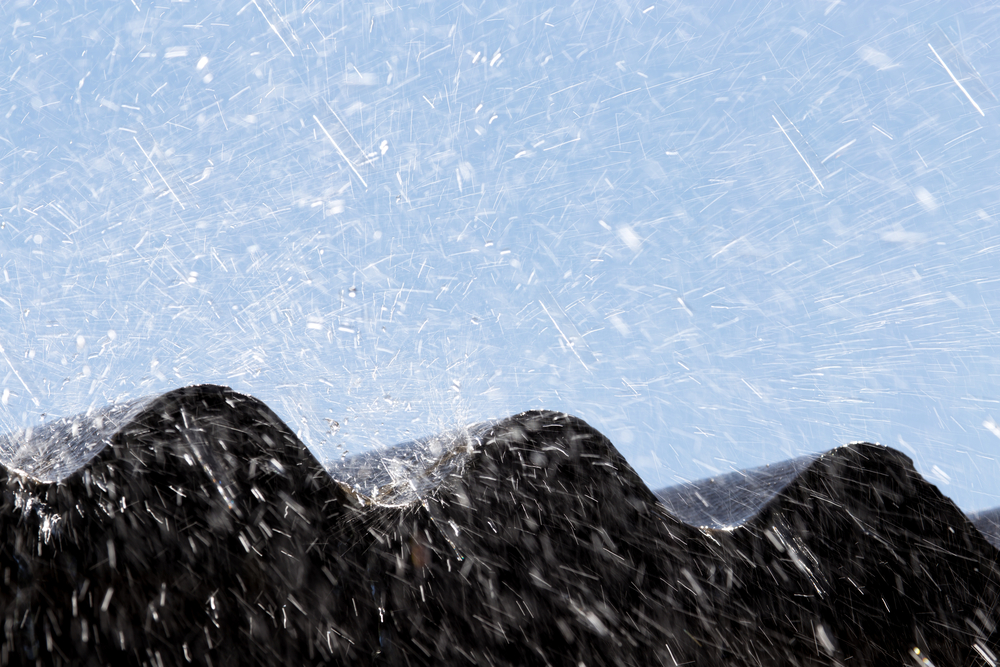
by siteadmin | Jul 19, 2019 | Roofing Materials, Severe Weather
Hurricane season lasts until Saturday, November 30. During this time of year, the chances of a hurricane or tropical storm increase substantially, making storm preparations a necessity. If you’re looking to replace or renovate your roof before severe weather hits, consider upgrading to a more durable roofing material more likely to survive any upcoming storms.
Most roofing materials can survive severe weather if properly installed. However, some are more durable than others, particularly if the storm has especially high winds. Before you choose a permanent roofing option, consult with a professional roofing company to see which choice can best withstand the storms you’re likely to face.
Metal
As one of the most durable roofing materials on the market, metal rooftops can withstand winds over 100 miles per hour. It’s also hard for ice to form on a metal roof, preventing severe damage from a cold snap. However, remember that metal expands and contracts with dramatic changes in temperature. This does make a metal roof slightly more vulnerable to leaks than other materials.
Shingles
The majority of homeowners choose conventional shingles as a roofing material because of their cost-effectiveness, high quality, and variety of styles. Well-made asphalt shingles can easily withstand severe weather and high winds, as well as repelling rain off your roof. The biggest vulnerability of a shingle roof comes if the shingles aren’t properly nailed down and blow off the roof, letting rainwater into your house. Fortunately, making sure your shingles get plenty of nails and regular maintenance should prevent this from happening.
Pro Tip: Schedule a free roof inspection and let an expert determine if your shingles need reinforcements to protect you from severe weather.
Tiles
Made of concrete, slate, or clay, roof tiles provide an elegant look to your home. These tiles are also very hard and can easily last for decades once installed. Their weight makes it nearly impossible for winds below 120 miles per hour to knock them loose. However, homeowners should be aware that roofing tiles cost more than shingles or metal, and tend to be brittle if handled improperly. The materials must be transported and installed with expert precision.
A Wind-Resistant Houston Roof
At the end of the day, remember that while some choices may be more durable than others, a particularly severe hurricane can damage your roof and make emergency repairs a necessity. Your best bet is to meet with your roofing contractor beforehand and discuss your options for a new roof. If they can suggest the best roofing material for high winds for your roof, take their advice and save yourself some trouble later on.
Connect with us to learn more about preparing your home for severe weather this hurricane season.

by siteadmin | Jul 12, 2019 | Roof Damage, Roof Repair, Severe Weather
A well-structured roof can last for years and take plenty of abuse from the weather. However, part of maintaining your roof’s lifespan is handling small incidents as they happen. If you’re beginning to notice that your roof leaks in heavy rain or even in a drizzle, it’s time for repairs.
A leaky roof is more than an inconvenience. The potential for severe water damage to the rest of your roof and to the house itself is too great to put off repairs too long. In the meantime, however, there are a few things you can do to keep the water from causing too many problems while you wait for emergency roof repairs.
Contain and Drain the Leak
If you can see a dripping spot on your ceiling, place a bucket underneath to catch the water. Once the initial dripping is contained, see if there’s a dark spot or bulge where the water is dripping from. More than likely, rainwater is pooling back there and will eventually burst out. With a little care, you can prevent this from happening. Stand on a ladder as close to the leak as you can and gently insert a screwdriver into the bulge or dark spot to drain the excess water. While you may see increased water flowing into the bucket briefly, this will prevent too much water from accumulating and causing further damage.
Temporarily Cover the Leak
Do this ONLY if you are confident you know where the leak is on your roof and if it is safe to climb on your roof. Locate the source of the leak and cover it as best you can with a waterproof tarp. If you can find the same leak inside your house, cover the interior with a tarp as well. While this is just a temporary fix, it will prevent the damage from worsening in the meantime. Even professional roofing companies can’t repair your roof in bad weather.
Pro Tip: NEVER climb on your roof during a rainstorm. Roofing material becomes slick when wet and you can easily fall.
Watch for Other Damage
Ignoring a roof leak will not make it better. Monitor your roof and the surrounding areas for any additional signs of damage. It’s probably time for a more intensive roof repair if you notice any of these warning signs:
- Dark spots or sagging on the inside ceiling
- Missing, broken, or warped shingles
- Clogged roof gutters or drains
- Missing roofing material around vents, chimneys, etc.
Emergency Houston Roof Leak Repair
Once the leak is contained temporarily, call your local roofing contractor and schedule an emergency repair as soon as you can. Once the weather is clear enough for them to work, you should get the hole patched immediately. Don’t let your roof continue leaking and letting rainwater into your house.
Connect with us to learn more about temporarily containing leaks and inspecting your roof for damages.

by siteadmin | Jul 5, 2019 | Roof Damage, Roof Insurance, Severe Weather
Anyone familiar with severe Houston weather knows it’s very possible to take a lot of wind damage very quickly in a storm. At best, you might lose shingles and get a few leaks. At worst, half your roof could get blown off. The potential effects are simply unpredictable. And, unfortunately, wind damage roof insurance claims are not often addressed in insurance discussions.
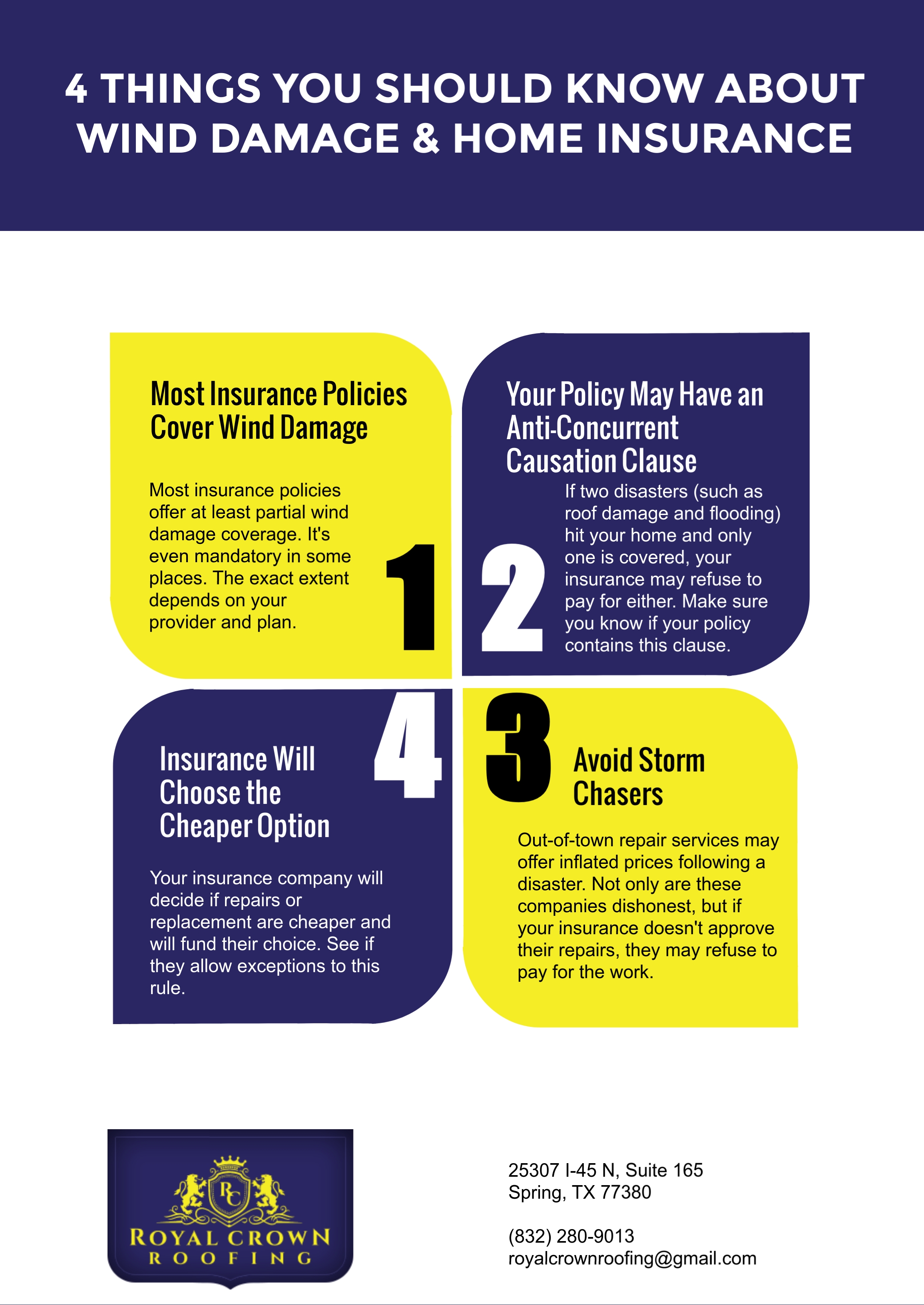
Are You Covered?
Before any severe weather arrives, make sure you know the details of these 4 critical points about your roof insurance. Knowing the full extent of your insurance coverage and preparing for the worst could save you an immense amount of money and frustration later on.
- Most insurance policies cover wind damage
- What is an anti-concurrent causation clause?
- Insurance will choose the cheaper option
- Avoid storm chasers
1) Most Insurance Policies Cover Wind Damage
Even if there are only a few sentences about wind damage in the fine print of your insurance information, you’re almost guaranteed at least partial coverage. The real question is how much cover do you have in practice, and when will the insurance company pay? Start by reading all the fine print in your policy and discuss this question directly with an agent when you can.
Pro Tip: In some areas, wind damage insurance coverage is mandatory. In other areas, this coverage is optional and may not be provided by major insurance companies. Make sure you know what’s in your policy.
2) What is an Anti-Concurrent Causation Clause?
Simply defined, an anti-concurrent causation restriction states that if your home is affected by two disasters (such as roof damage and flooding) and only one disaster is covered, the insurance company may refuse to cover either expense. Obviously, this could be a nasty surprise to anyone already dealing with a devastated house. Don’t wait until the last minute to find out if your policy has this! If you aren’t sure, contact your insurance agent and ask them to clarify any language that seems confusing.
3) Insurance Will Choose the Cheaper Option
This will come as no surprise to anyone who has ever filed an insurance claim before. If your roof is badly damaged by wind, the insurance company will decide if repairing or replacing is the cheaper option, and will finance their choice. This policy usually makes sense. However, if the insurance company opts to repair an older roof with brand-new parts, the additions may not be compatible in terms of cosmetics or practicality. Talk with your insurance provider about potential compromises to this policy.
4) Avoid Storm Chasers
After a hurricane or severe weather event, plenty of out-of-town repair services see their chance to make quick money and swoop in on the desperate homeowners, offering “discounted” services. If a roofing company suddenly shows up and offers you repairs, don’t fall for their dishonest pitches. Stick with a local, reliable roofing company with a proven track record in your area. Not only will the final product be better in quality, but you’ll also avoid the scammy tactics of storm chaser companies.
Wind Damage and Roof Insurance Claims in Houston
The first step to restoring a wind-damaged home is fixing the roof. After all, an unprotected roof will continue to allow rain and wind inside the house, making damages worse. Make sure your insurance will help you get your roof back in shape so you can focus on more severe repairs.
Join the conversation to learn more about roof insurance claims and handling wind damage.
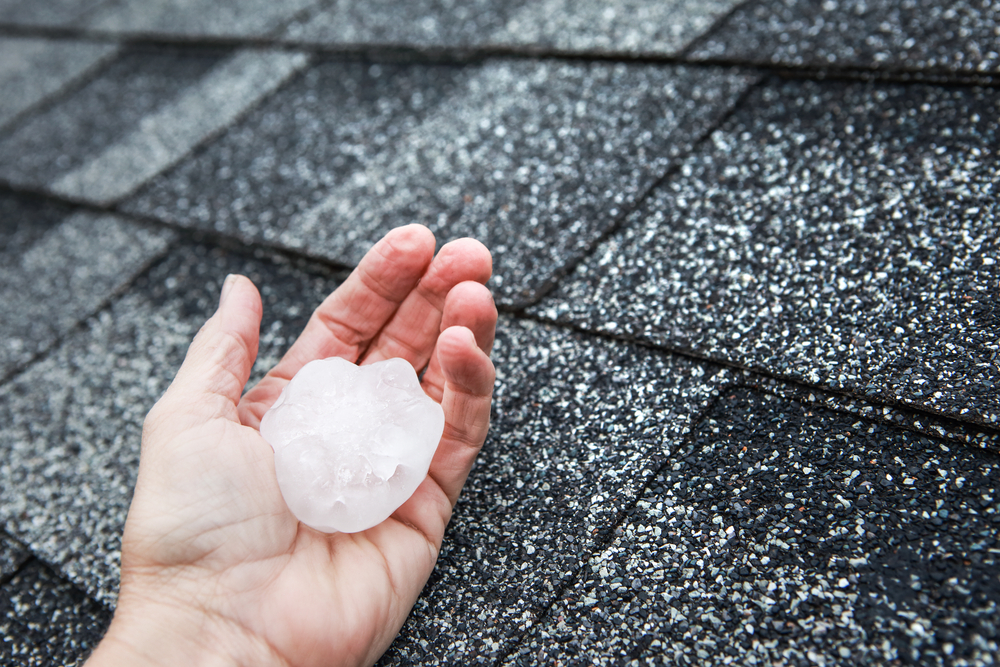
by siteadmin | Jun 28, 2019 | Roof Damage, Roof Repair, Severe Weather
A few short weeks ago in early May, severe rainstorms in Houston brought with them golf ball-sized hail, reaching the size of baseballs in some regions. If you were among the thousands of affected families, it may be time to have a professional inspect your roof and home for damage.
Drastic hail damage, such as smashed windows, is easy to spot and arrange repairs for. However, don’t assume you just got lucky if your home escaped severe damage. Even without knocking a hole in your roof or dislodging shingles, hail can leave subtler problems behind. A professional roof repair company can help you assess the total damage and decide whether a full replacement or a few repairs are necessary.
What is Your Woodlands Roof Made Of?
Your roofing materials will help you determine the extent of the damage and potential repair costs. For instance, a metal roof will dent when exposed to heavy, rapid-fire hail. A minor dent might cause a little trouble with water flowing off your roof, while a major dent could be an indication of more severe damage underneath in your home itself. Meanwhile, clay or wooden shingles will split or shatter in a hailstorm, allowing damage to spread quickly.
Asphalt shingles, the most common roofing material, may lose granules during a hailstorm. In a severe case, the damage will be obvious. Other times, the missing granules will be so subtle that only a professional eye can spot them. Either way, missing granules indicate a high level of force from the hail and could be a symptom of more severe damage under the tiles. At the very least, the newly formed weak spot can turn into a leak.
What Will Your Insurance Cover?
Your roofing company can help you negotiate with your insurance provider and determine your next course of action. If the damage is severe enough that a full replacement is necessary, your insurance company will pay for a new roof. However, repairs get tricky. Some insurance providers consider certain minor repairs as cosmetic and not as critical as emergency storm repair. Your best strategy is to have your roof professionally inspected and then negotiate with your insurance company with an estimate in hand.
Pro Tip: From time to time, have your roof inspected even if you aren’t sure any damage has occurred. A professional opinion can help you prevent a minor problem from becoming worse in severe weather.
Is More Damage Likely?
Is local weather projected to get even worse and potentially damage your roof further? More importantly, how long can you really wait to fix the immediate problem? A few missing granules off a shingle ultimately require a new shingle, but your roof won’t start leaking immediately. On the other hand, missing shingles or leaks require immediate attention. Talk with your roofing contractor for a long-term plan and timeline for your roof repair.
Repair or Replace the Roof
Ultimately, your decision to replace the whole roof or pay for a few repairs will depend on your roof builder’s suggestions, the extent of the damage, your insurance’s contribution, and the likelihood of things getting worse. Different circumstances call for different solutions. Find the solution that works best for your situation.
Connect with us to schedule your free roofing inspection today and have a professional assess the damage to your roof.
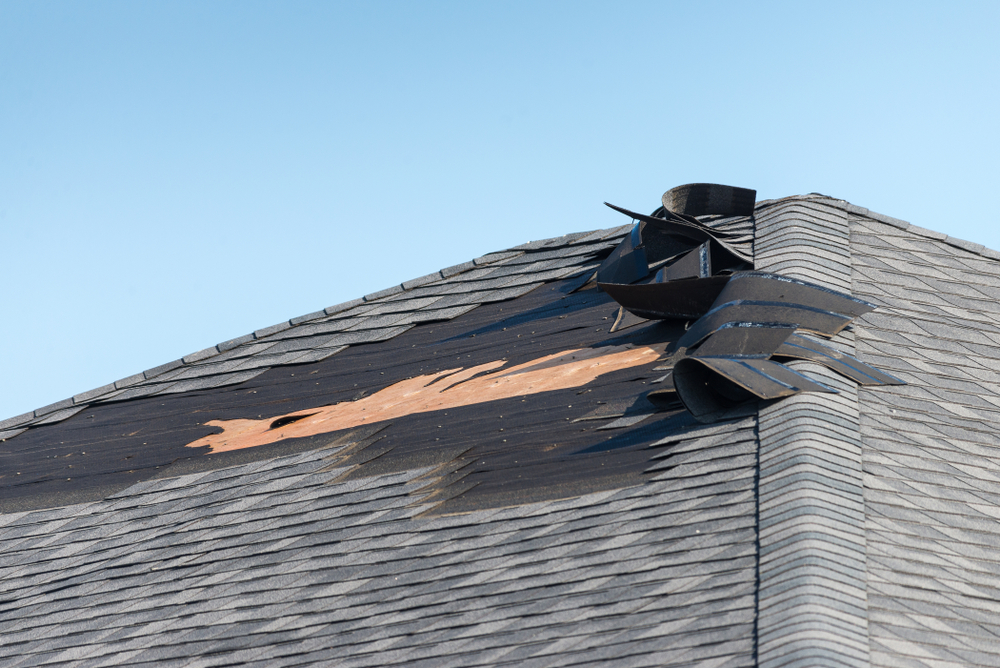
by siteadmin | Jun 21, 2019 | Roof Damage, Roof Repair, Severe Weather
A well-built roof is your home’s first line of defense against heavy rain, hail, and other damages from severe weather. But what happens when the roof takes damage? Depending on the severity of the storm and the extent of the damage, you will likely have to take action quickly to repair your roof.
When your roof has suffered storm damage, the best course of action is to determine how bad the damage is and contact a professional roof builder immediately. Don’t delay! The longer your roof sits unrepaired, the more likely you are to suffer further damage in the meantime.
Assess and Document the Damage
As soon as it is safe to do so, go outside and perform a self-assessment of your roof damage. Take pictures to document everything for insurance purposes later. A few missing or dislodged shingles might not need repairs quickly, but huge patches of missing shingles or cracks in the roof need immediate attention.
Contact a Professional for a Repair Estimate
Once you know the extent of the repairs you’ll likely need, contact your local roofing company for an estimate on repair cost and time. If the same company built your roof originally, talk to them about their warranties and insurance. How much of the payment will come out of your pocket? Contact your own insurance company as well to see what they will cover.
Pro Tip: If your local roofing company can’t perform repairs immediately, ask for a temporary fix or covering to prevent further problems with your roof.
Don’t Hire a Storm Chaser
Above all, don’t get scammed! After severe weather damages several local houses, “storm chasers” often appear out of the woodwork offering quick roofing repairs. However, very often these companies perform subpar repairs or none at all and just disappear with homeowners’ money. If a roofing company you’ve never heard of tries to solicit your business, ignore them. More than likely, they’re trying to scam you. Stick with a verified roofing company you can trust to actually help you.
Dealing with Severe Weather Damage
Don’t let your storm-damaged roof sit in disrepair and continue allowing the elements into your home. Get in touch with a professional roofing repair service and keep the problem from worsening. Your newly repaired roof will be able to withstand future storms.
Connect with us to learn more about the storm damage repair services we offer.
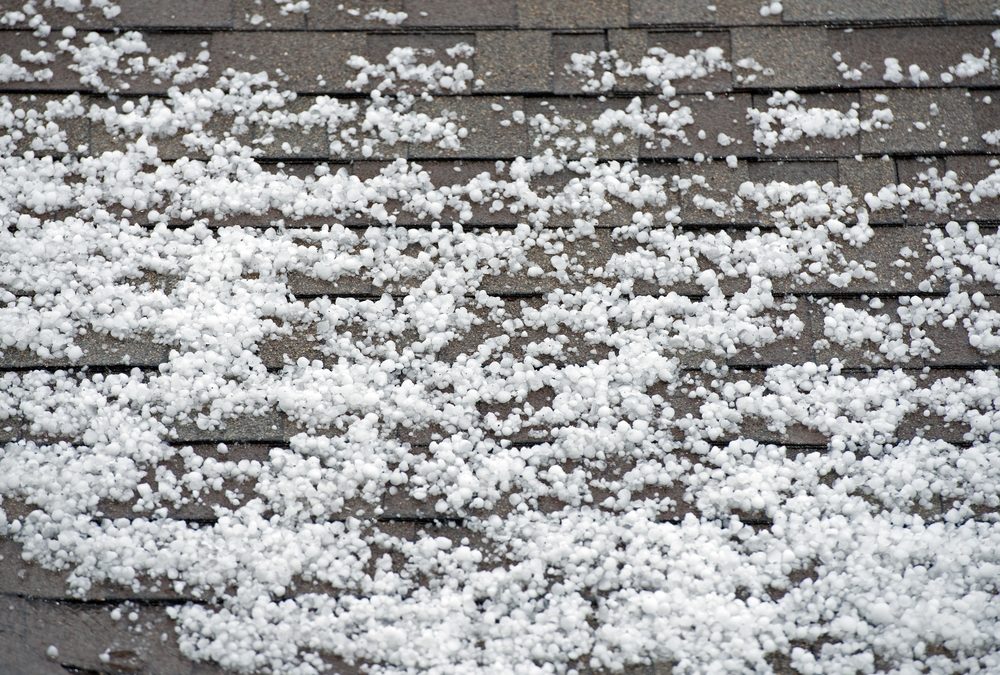
by siteadmin | Jun 14, 2019 | Roof Damage, Roof Inspection, Severe Weather
While weatherproofing your roof and home can drastically decrease the damage caused by a storm, no protective measure is perfect. Particularly nasty storms can still cause some damage to your roof. This hurricane season, we can expect severe thunderstorms that could give you trouble. After a storm passes, make sure to inspect your roof for any damage that requires an immediate fix.
Catching roof damage in its early stages prevents the problem from spreading and costing you more in repairs later on. Even if you’re fairly confident your roof can withstand a storm, perform a brief inspection after a particularly nasty bout with wind and rain. It’s better to be safe than sorry.
Water Stains
Even if you can’t see any uncovered spots on your roof, a water stain on the inside will tell you there’s a leak. Water spreads quickly and can cause expensive damages, so the sooner you can catch a water stain, the better. Check the inside of your roof for dark, warped, or damp spots.
Pro Tip: If you find mold growing inside your roof, you’ve likely had a water leak for a while. It’s time to call for emergency repairs.
Hail Damage
Houston doesn’t get hail often, but it definitely leaves an impression. After a hailstorm, look for dents or fractures on your roof that could let in water. Check the inside for water stains as well even if nothing seems immediately obvious. Hail is not a force of nature to be reckoned with. Make sure it doesn’t destroy your roof.
Cracked, Missing, or Curling Shingles
Asphalt shingles do a remarkable job repelling water as long as they’re in place. If wind or falling debris dislodge your shingles, water can get in through your roof and damage your home. Shingles can also curl in the hot sun if they aren’t nailed down properly, providing more entryways for rain. Always check after a storm and note any shingles that are missing or appear to be broken. An emergency repair service will provide you with a temporary leak cover while they work on a long-term solution.
Inspecting for Roof Damage
As you assess the state of your roof after a storm, remember that you will likely not catch everything. Call a professional roofing company for a roof inspection and assessment of the damage. Once you have a better idea of what happened and how much damage occurred, you can make plans to repair your roof.
Join the conversation to see what storm damage might look like and learn more about how to prevent it.










